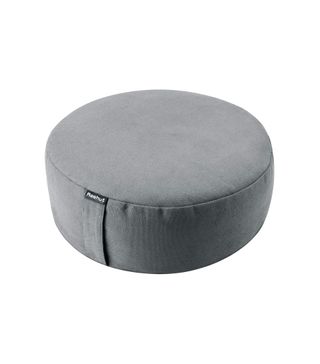Meditation Can Reduce Your Anxiety—Here's How to Make It Effective
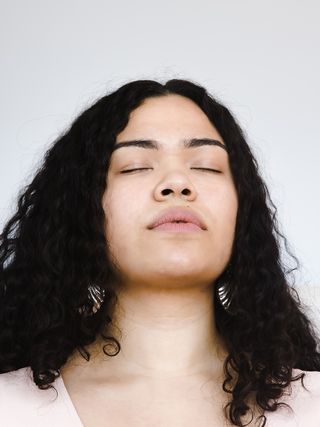
It seems like almost everyone is dealing with stress and anxiety these days. And it comes from anywhere and everywhere: the news, work, relationships (of all kinds, even with ourselves), society, and more. "As we all know, stress is a global issue, with one in three people experiencing psychological and physiological symptoms caused by stress," explains Deepak Chopra, MD, pioneer of integrative medicine, founder of The Chopra Foundation and Chopra Global, and co-creator of Fitbit's Mindful Method. "Stress and anxiety are even more prevalent during the pandemic. Adults in the U.S. reported the highest rate of mental health concerns like stress, anxiety, and sadness from March 2020 to May 2020."
I think it's safe to say that all of us are looking for ways to cope. Some people might turn to exercise. Others might turn to hobbies or passions. They might also try to make some lifestyle changes. Some might even seek professional help. But you want to know another potential remedy for anxiety? It's meditation.
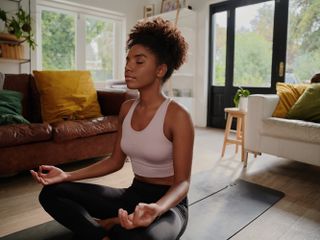
The practice of meditation has been around for centuries. "The Sanskrit word for meditation is Dhyana. Meditation is a yogic practice that has its origins from the Indian subcontinent from ancient times," explains Vibay Chandran Weisbecker, Mindbody's Holistic Wellness & Mindfulness Expert. "While the ancient sages of the subcontinent used this practice to self-realize, meditation has great benefits to the modern human being as well. Meditation can be practiced in a variety of different ways and can meet the practitioner where they are at with their meditation practice (beginners or advanced meditators)."
It's taking some time out of your day to train the mind and cultivate awareness and compassion. "The breath is often used as the object of focus but it could also be sensations in the body, sounds, or visualizations where you bring to mind an image," says Eve Lewis Prieto, director of meditation and mindfulness Teacher at Headspace. "By training the mind to be more present, open, and at ease, we tend to experience great calm, clarity, and contentment in our lives."
And you can talk about meditation without discussing mindfulness, which comes from the meditation practice. Lewis Prieto says mindfulness is moment-to-moment awareness, free from distraction, judgment, or criticism, with a soft and kind. You can practice mindfulness outside of meditation, too, by just bringing awareness to what you are doing.
How Meditation Can Reduce Anxiety

First, Lewis Prieto says it's important to acknowledge that both stress and feelings of anxiety are normal parts of the human experience. Stress is our body's natural response to challenging external events or situations, that resolve when the external event passes, she explains. It might cause emotional or physical tension and distress, and it might leave you feeling angry, frustrated, nervous, or scared. The body also releases stress hormones like cortisol and adrenaline during this time.
"Anxiety often occurs in response to a stressor and is characterized by persistent worry and tension in the mind and body even when the stressor is not present," Lewis Prieto explains. "This is why when people describe feeling anxious they often describe butterflies in the stomach, a sickly feeling, tight chest and shallow breathing, and an overall nervousness in the body, and this can feel like a very physical experience. Anxiety disorders differ from everyday feelings of anxiety in that the symptoms (worry, tension, feelings of fear, etc.) can persist for months."
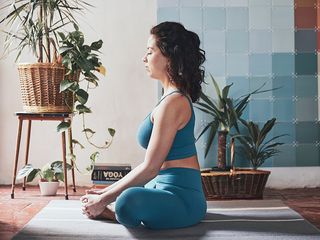
When you practice meditation, you learn to observe and understand the mind. It helps give you another perspective. "In doing this we not only train the mind to meet each moment with a kind and compassionate awareness, but we are better able to recognize when we are getting caught up in anxious or worried thoughts," Lewis Prieto says. "Meditation teaches us how to put some distance between ourselves and those thoughts and feelings; to let go of judgment and criticism; and to self-regulate physical and emotional responses to stress and anxiety. It provides a space to cultivate a sense of balance in the mind and an evenness of mind no matter what is happening."
There is science behind it, too. Chandran Weisbecker cites a study conducted by the American Psychological Association, which found that frequent meditators showed significantly fewer stressors and illness symptoms. So, a regular practice of mediation can reduce these anxiety and stress levels.
How to Use Meditation to Combat Anxiety
1. Find Time
"Finding time to meditate on high-stress days is even more important than on good days," says Chandran Weisbecker. "On such days it becomes crucial to place yourself in a space or room where you can sit quietly to pause and reflect." It might help to schedule time in your day for your practice.
2. Do a Body Scan
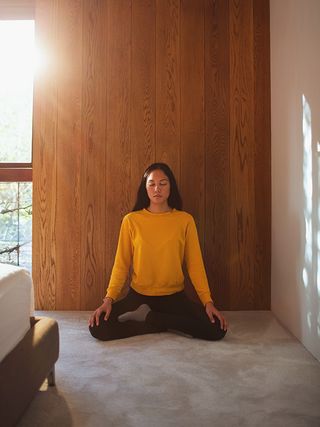
When you get so inside your head, it can be hard to be aware of your surroundings, or even your body. Prieto suggests doing a body scan to help slow down your thoughts and relax your muscles. She recommends sitting comfortably in a chair or lying down, and then taking a couple of big deep breaths, focusing on the lungs filling up and the body softening as you exhale.
"Start by sitting comfortably in a chair or lying down (I prefer to lie down and close my eyes). Take a couple of big deep breaths focusing on the lungs filling with air and the body softening as you exhale, she says. "Feel the weight of your body pressing down in the seat or the surface and pay attention to the different points of contact. Place your attention at the top of your head and very slowly scan down through each part of your body at an even pace. Without any judgment, notice how your body feels. It may not feel the same as yesterday, and that is okay. Don't worry if your mind wanders—just gently let the thought go and return to your body scan until you have reached your toes. Repeat two to three times."
3. Focus on Your Breathing
You can also just pay attention to your breathing. Chandran Weisbecker recommends sitting in a comfortable position with your spine lifted, and focusing on your breath. "Once you start to notice the sensation of your inhalations and exhalations, begin to close your eyes," he says. "Every time the mind wanders, bring it back to your breath. Sitting this way for five to eight minutes is a good place to start."
4. Go on a Mindful Walk

"Another great exercise to do when feeling really anxious is going for a mindful walk," Lewis Prieto suggests. "Again, when we are feeling anxious, we are often really caught up in the mind. So getting outside, paying attention to your surroundings and the movement of your body really helps to close the loop."
5. Try the STOP Method

Chopra says mindfulness can start with simple, everyday actions. He created the Mindful Method for Fitbit, which includes dozens of meditations and mindfulness for any need—whether you want to reset a bad mood, need a pick-me-up during a stressful workday, or want to prepare for sleep. He says the main technique is based on the four pillars of wellbeing: mind, body, emotions, and spirit.
He also gives this quick trick. "I use something called the STOP method," he says. "S stands for 'stop,' T stands for 'take three deep breaths and smile,' O stands for 'observe the sensation of your body and breath,' and P stands for 'proceed with awareness and compassion.' There are a lot of little tricks like this, which are instant stress busters."
6. Try Alternate Nostril Breathing
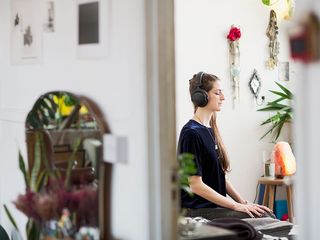
Chandran Weisbecker says this technique is a great way to release stress quickly. "Be seated in a comfortable pose with your spine lifted," he says. "Hold your left nostril down with your right index finger as you breathe in from your right nostril, then let go of your breath from the left nostril as you hold your right nostril down with your thumb. Now inhale through your left nostril as you hold your right nostril down with your thumb and release breath through your right nostril. Keep alternating on both sides at least 10 times. You may momentarily feel light-headed; simply slow down your breath to return to normal breathing."
7. Try a Wind-Down Exercise
Lewis Pietro recommends a wind-down exercise before you go to bed, like doing a relaxing activity such as reading a book or taking a warm bath. Then, try meditation or another calming routine. "Sleep by Headspace is a soothing, bedtime experience that creates the perfect conditions for healthy, restful sleep," she says. "It offers Sleepcasts, sleep music, wind-downs, soundscapes, and guided exercises to help with waking up in the night and ease the mind into a truly restful night’s sleep."
Other Meditation Tips to Keep in Mind

If you're new to meditation, don't feel intimidated. It takes some practice and patience, and it's not quite something you can pick up overnight. Here are a few things to keep in mind as you're practicing, whether you're a newbie or not:
Go easy on yourself: Lewis Prieto says it's important to not put too many expectations on yourself. "Be patient with yourself. It can also be really helpful to remind yourself of your intention for doing it, that could be to feel less anxious. It can serve as a great reminder to keep practicing," she says.
Be consistent: "It's a common misconception that meditation takes months—even years—to see benefits," Lewis Prieto says. "That's not the case at all. Sessions can take as little as ten minutes each day, and it doesn't have to be daily. In fact, many studies show positive results with a consistent meditation practice three to four times a week." She recommends thinking of learning to meditate like learning any kind of skill—it's like exercising a muscle that you've never really worked out before. Consistent practice will make you feel more confident and comfortable with it.
Create a space: The environment you're in is also important. Chandran Weisbecker says it's all about set and setting. "Make a sacred space for yourself at home where you can drop into, with relative ease, into silence," he says. "Make the space yours by placing your favorite plants, crystals, idols, pictures of loved ones, a comfortable floor pillow, or a chair for you to sit on. It may not always be a silent space, and when it becomes noisy it is a good opportunity to practice some equanimity and detachment."
Be deliberate: "I understand that trying to maintain your health today is hard, but it's also more important than ever to take care of yourself," Chopra says. "Everyone can incorporate mindfulness and meditation into their day, whether just starting out or looking to deepen an existing practice." And it doesn't have to take up a huge chunk of your day—just a few minutes can make a difference.
Don't worry so much about clearing the mind: This is the part that I get caught up on a lot as I'm trying to meditate. I always thought that it was just about making my mind totally empty, and when I couldn't I would be really frustrated. But Chopra says not to worry too much about this. "Meditation isn't about stopping our thoughts or trying to empty our minds—both of these approaches only create stress and more noisy internal chatter," he explains. "We can't stop or control our thoughts, but we can decide how much attention to give them. Although we can't impose quiet on our mind, through meditation we can find the quiet that already exists in the space between our thoughts. Sometimes referred to as 'the gap,' the space between thoughts is pure consciousness, pure silence, and pure peace."
Attach it to another everyday activity: Lewis Prieto says "little and often" is the best way to get established with a practice. "A great way to do that is by attaching it to something you already do, like after brushing your teeth in the morning or after breakfast. Some may also find it helpful to schedule a recurring meeting in your calendar every day for ten minutes," she says.
Products for Your Meditation Practice

A meditation pillow comes in handy because you'll want to be comfortable during your practice. The filling contains natural buckwheat, plus pieces of amethyst and quartz for crystal healing.
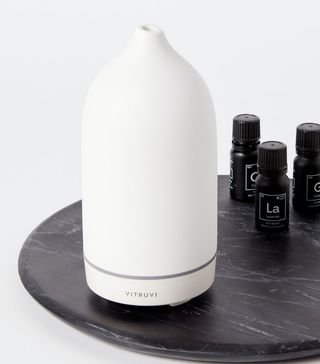
Aromatherapy can help set the mood, and the easiest way to reap the benefits is through a diffuser.

This book can help you get started. It starts with short, five-minute exercises and then builds up more advanced rituals.

With notes of coastal rain, eucalyptus shoot and leaf, magnolia, Pacific spray, and wet wood, how can you not feel so calm and transported when you burn this candle?

This meditation kit has everything you need to unwind at the end of the day: a lavender grow kit, a five-minute hourglass timer, and an essential oil roller.
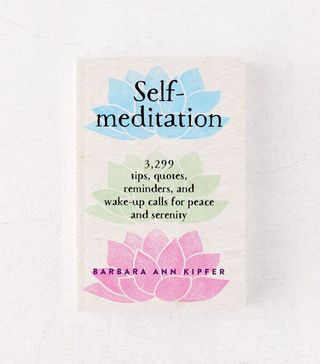
Here's another book to help you on your meditation journey. There are hundreds of suggestions for any kind of situation you find yourself in, including one for when you're waiting in line, or one to do while you're enjoying a cup of tea.
Next: Breath Work Is a Powerful Self-Care Tool and Is More Accessible Than You Think
Disclaimer
This article is provided for informational purposes only and is not intended to be used in the place of advice of your physician or other medical professionals. You should always consult with your doctor or healthcare provider first with any health-related questions.
Sarah is lifestyle writer and editor with over 10 years of experience covering health and wellness, interior design, food, beauty, and tech. Born and raised in Los Angeles, she attended New York University and lived in New York for 12 years before returning to L.A. in 2019.
In addition to her work on THE/THIRTY and Who What Wear, she held editor roles at Apartment Therapy, Real Simple, House Beautiful, Elle Decor, and The Bump (sister site of The Knot).
She has a passion for health and wellness, but she especially loves writing about mental health. Her self-care routine consists of five things: a good workout, “me” time on the regular, an intriguing book/podcast/playlist to unwind after a long day, naps, and decorating her home.

